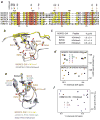Multivalent Chromatin Engagement and Inter-domain Crosstalk Regulate MORC3 ATPase
- PMID: 27653685
- PMCID: PMC5074691
- DOI: 10.1016/j.celrep.2016.08.050
Multivalent Chromatin Engagement and Inter-domain Crosstalk Regulate MORC3 ATPase
Abstract
MORC3 is linked to inflammatory myopathies and cancer; however, the precise role of MORC3 in normal cell physiology and disease remains poorly understood. Here, we present detailed genetic, biochemical, and structural analyses of MORC3. We demonstrate that MORC3 is significantly upregulated in Down syndrome and that genetic abnormalities in MORC3 are associated with cancer. The CW domain of MORC3 binds to the methylated histone H3K4 tail, and this interaction is essential for recruitment of MORC3 to chromatin and accumulation in nuclear bodies. We show that MORC3 possesses intrinsic ATPase activity that requires DNA, but it is negatively regulated by the CW domain, which interacts with the ATPase domain. Natively linked CW impedes binding of the ATPase domain to DNA, resulting in a decrease in the DNA-stimulated enzymatic activity. Collectively, our studies provide a molecular framework detailing MORC3 functions and suggest that its modulation may contribute to human disease.
Copyright © 2016 The Author(s). Published by Elsevier Inc. All rights reserved.
Figures







References
-
- Dutta R, Inouye M. GHKL, an emergent ATPase/kinase superfamily. Trends in biochemical sciences. 2000;25:24–28. - PubMed
-
- Fiorentino DF, Chung LS, Christopher-Stine L, Zaba L, Li S, Mammen AL, Rosen A, Casciola-Rosen L. Most patients with cancer-associated dermatomyositis have antibodies to nuclear matrix protein NXP-2 or transcription intermediary factor 1gamma. Arthritis and rheumatism. 2013;65:2954–2962. - PMC - PubMed
-
- Guo X, Wang L, Li J, Ding Z, Xiao J, Yin X, He S, Shi P, Dong L, Li G, et al. Structural insight into autoinhibition and histone H3-induced activation of DNMT3A. Nature. 2015;517:640–644. - PubMed
MeSH terms
Substances
Grants and funding
LinkOut - more resources
Full Text Sources
Other Literature Sources
Molecular Biology Databases

